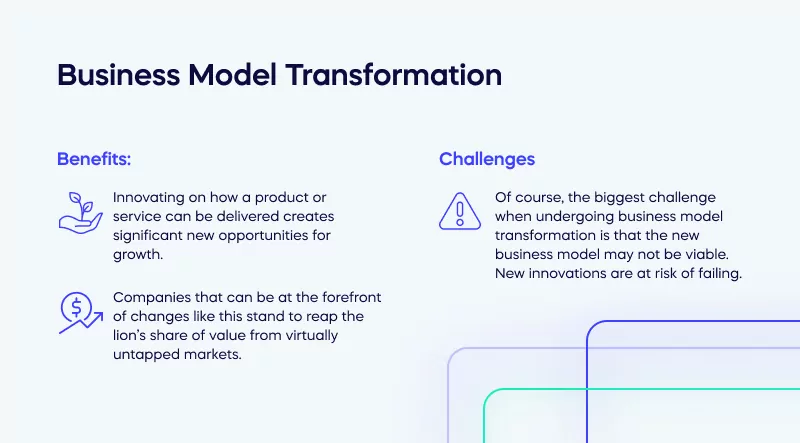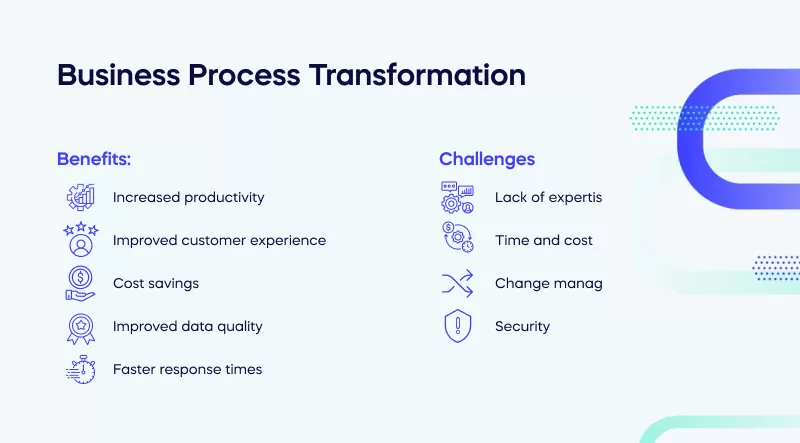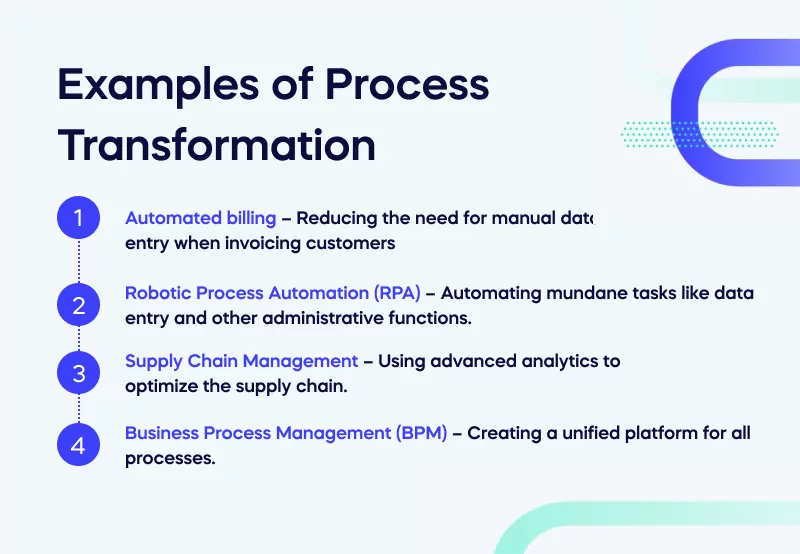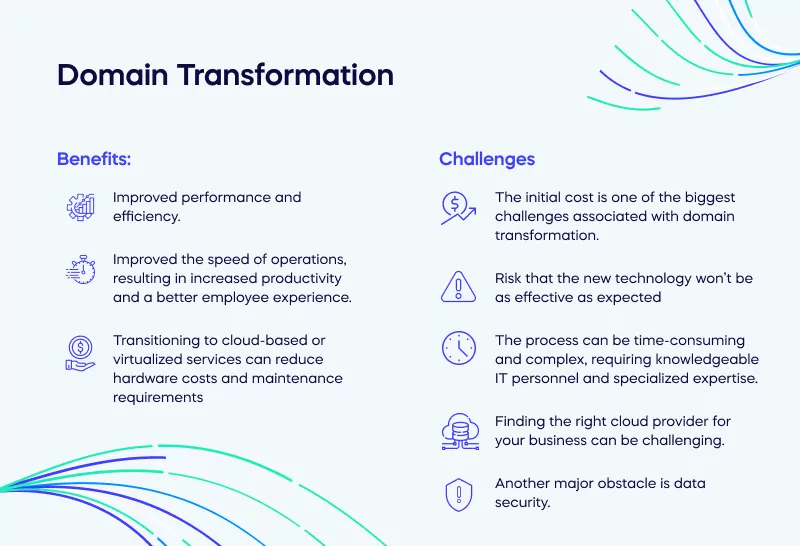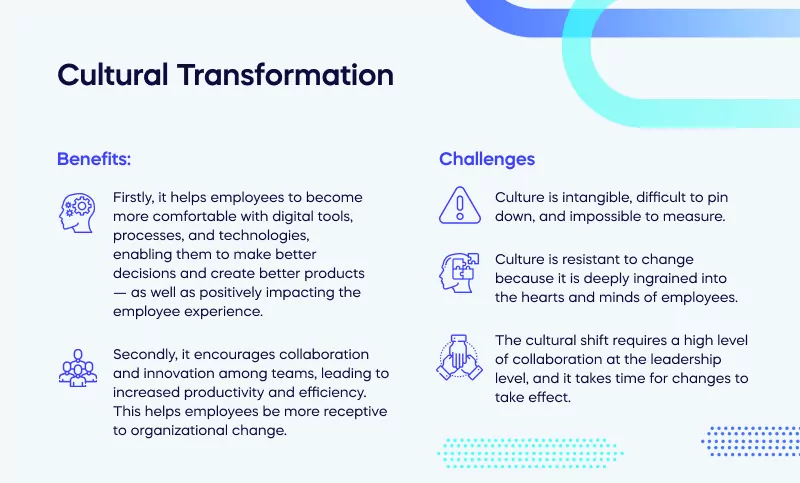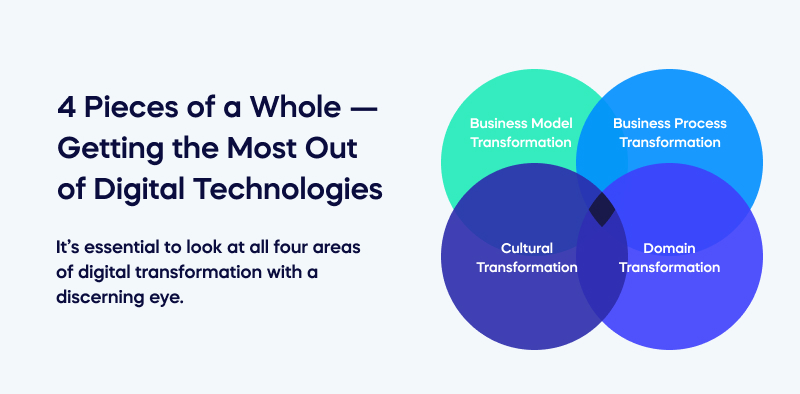Businesses delving into digital transformation for the first time often make one common mistake.
They see digital transformation as a project with a starting mark and a finish line. They believe their business will be ” digitally mature by undergoing digital transformation.”
They’re not necessarily wrong, but true digital transformation is more nuanced than that. Rather than a project, it’s more like a philosophy. And digital maturity is a constantly shifting scale.
Taking all of this in can be overwhelming so we will break digital transformation down into four main focus areas in this article.
These are:
-
Business model transformation
-
Business process transformation
-
Domain transformation
-
Cultural transformation
All digital transformations fall into one of these four areas, and by focusing on one area at a time, digital transformation is a much more digestible idea.
We’ll dig into these four focus areas, exploring the benefits and challenges associated with each.
What are the four main focus areas of digital transformation?
We will examine the four main areas of digital transformation to understand how it works and the impact it can have on businesses. We will showcase examples of each focus area and highlight the benefits and challenges.
Business model transformation
Business model transformation refers to using digital technologies to change and improve a business’s core operations.
For some, using new technologies to create new business models could mean using artificial intelligence (AI) to enable a dynamic pricing strategy that changes prices based on several factors— like how airline tickets are priced.
For others, it could mean pursuing digital technologies to enable you to offer a product or service in a new, innovative way.
Examples of business model transformation
Usually, business model transformations use digital technologies to add value or solve a problem. For example:
Netflix reinvented video distribution by leveraging cutting-edge improvements to internet infrastructure and streaming capabilities. They seized the opportunity as soon as the required digital solutions were available.
Apple innovated how music could be distributed as personal computing became more commonplace. Spotify then took this a step further as personal mobiles improved.
Benefits of business model transformation
Both of these examples provided huge benefits.
Innovating on how a product or service can be delivered creates significant new opportunities for growth.
Companies that can be at the forefront of changes like this stand to reap the lion’s share of value from virtually untapped markets.
Challenges of business model transformation
Of course, the biggest challenge when undergoing business model transformation is that the new business model may not be viable. New innovations are at risk of failing.
For example, Google tried to do for gaming what Netflix did for movies with their Stadia project— which has now been discontinued.
Business process transformation
Process transformation focuses on optimizing business processes to make them more efficient and cost-effective.
You can reduce costs, improve customer satisfaction, and increase profitability through business process transformation.
A process transformation initiative might mean you use artificial intelligence to automate business processes, re-engineer existing business processes, or introduce new technologies into existing processes.
Examples of process transformation
Here are some of the most common examples of process transformation in business:
• Automated billing – Reducing the need for manual data entry when invoicing customers.
-
Robotic Process Automation (RPA) – Automating mundane tasks like data entry and other administrative functions.
-
Supply Chain Management– Using advanced analytics to optimize the supply chain.
-
Business Process Management (BPM) – Creating a unified platform for all processes.
-
As you can see, process transformation is all about streamlining operations.
Benefits of process transformation
The benefits of process transformation are as broad as the possibilities— which are endless.
Generally, though, you can expect to reap these kinds of rewards:
-
Increased productivity – Automating mundane tasks and creating efficient processes means you can do more with less.
-
Improved customer experience – Streamlining processes leads to a more accessible, smoother customer experience.
-
Cost savings – Automating processes and streamlining the supply chain can help save on resources and reduce costs.
-
Improved data quality – Process transformation can help reduce errors and improve data quality, allowing you to derive more valuable insights using tools like machine learning.
-
Faster response times – Streamlined processes mean faster responses to customer inquiries, market shifts, or feedback.
Challenges of process transformation
While process transformation can help you realize various benefits, it’s also one of the most challenging areas of digital transformation to tackle. Here’s why:
-
Lack of expertise – Many businesses lack the digital skills to effectively implement process transformation and rely on consulting services.
-
Time and cost – Implementing process transformation takes time and money. Usually, new processes run alongside old ones, and even a successful transition period can be highly inefficient.
-
Change management – Process transformation requires significant changes to existing processes, which can be difficult for employees to adjust.
-
Security – If not properly managed, introducing new technology can lead to security risks.
Domain transformation
Some define domain transformation as a shift in a company’s market domain. In other words, a business uses a digital transformation project to majorly change its products or service offerings.
Others define domain transformation as a major upgrade to an organization’s IT infrastructure network— known as its network domain. It includes the hardware, software, and connectivity components used by the business’s IT systems.
We will cover all bases and explore market and network domain transformations so you can get the full picture of how domain transformation works.
Examples of market domain transformation
Amazon’s shift from a book-selling business to an e-Commerce giant exemplifies a high-profile market domain transformation.
By actively listening to customer feedback and gathering data-driven insights, Amazon was able to refocus its operations, expanding into other areas such as tech, fashion, and household goods.
Amazon then performed a new market domain transformation when it launched Amazon Web Services (AWS).
Another example of domain transformation is Twitter’s move from a single product (a social media platform) to encompass the broader news and communication services market.
Benefits of market domain transformation
With domain transformation, businesses can:
-
Increase customer loyalty and satisfaction by offering more tailored services.
-
Create new revenue streams with innovative products or services.
-
Stay ahead of the competition by being ahead of the digital curve.
Challenges of market domain transformation
The biggest challenge associated with domain transformation is the cost.
Investing in new products, services, or technology can be risky without a clear return on investment (ROI). It’s not all that different from simply starting a new business.
This makes conducting extensive research and testing important before launching any new venture.
Furthermore, domain transformation requires companies to change their brand positioning and messaging. This can bring new challenges, particularly in creating a consistent customer experience across different channels.
The most successful domain transformations, like those of Amazon or Twitter, work out because the company leans into its own strengths. For example, Amazon already had access to massive storage spaces, which made it a little easier to set up storage server facilities.
Examples of network domain transformation
One widespread example of network domain transformation is Cloud Transformation.
This is when an organization moves its IT infrastructure to the cloud.
By doing so, they can eliminate on-premise hardware and benefit from increased scalability and reduced maintenance costs associated with cloud computing.
To take it a step further, they might switch from a private to a public cloud for better scalability and cost efficiency.
This digital transformation allows the organization to take advantage of the power of public cloud technology without bearing all the costs of maintaining internal cloud computing technology.
Benefits of network domain transformation
The main benefit of domain transformation is improved performance and efficiency.
Upgrading to newer and more powerful technology can improve the speed of operations, resulting in increased productivity and a better employee experience.
Additionally, transitioning to cloud-based or virtualized services can reduce hardware costs and maintenance requirements, but the initial cost can be challenging.
Challenges of network domain transformation
As mentioned, the initial cost is one of the biggest challenges of domain transformation.
Upgrading hardware and software requires a significant investment, and there is always the risk that the new technology won’t be as effective as expected.
The process can also be time-consuming and complex, requiring knowledgeable IT personnel and specialized expertise.
Finding the right cloud provider for your business can be challenging.
Another major obstacle is data security. Many businesses struggle to trust their private and sensitive customer data to a third-party cloud provider.
Cultural transformation
Successful digital transformation efforts are about more than just technology. It’s also about the cultural changes needed to make those technologies effective and promote digital innovation.
Cultural transformation enables organizations to move away from traditional, hierarchical internal values and shift towards a more collaborative, agile structure.
Organizations must create a culture that embraces digital transformation and encourages innovation.
Examples of cultural transformation
One example of cultural transformation is implementing new working methods, such as remote work or agile technologies.
This enables employees to work from wherever they are most comfortable and productive, increasing team collaboration. A global business can more easily tap into a global talent pool.
Another example is adopting a customer-centric mindset, where the customer is at the center of all decision-making. By understanding your customers’ wants and needs, you can create more meaningful experiences for them and exceed customer expectations.
Benefits of cultural transformation
The benefits of cultural transformation are twofold.
Firstly, it helps employees become more comfortable with digital tools, processes, and technologies, enabling them to make better decisions, create better products, and positively impact the employee experience.
Secondly, it encourages team collaboration and innovation, increasing productivity and efficiency. This helps employees be more receptive to organizational change.
Challenges of cultural transformation
Of all four areas of digital transformation, cultural transformation can be the most difficult to implement.
Culture is intangible, difficult to pin down, and impossible to measure.
It’s not a set of metrics in a database. It’s a set of shared values, beliefs, and norms. Culture is resistant to change because it is deeply ingrained into the hearts and minds of employees.
The cultural shift requires a high level of collaboration at the leadership level, and it takes time for changes to take effect. But it’s the foundation of every successful digital transformation journey.
4 pieces of a whole — getting the most out of digital technologies
Digital transformation efforts are complex yet powerful processes that have proven adequate repeatedly during periods of change or crisis.
By focusing on one area while planning your digital transformation strategy, you can increase the value you get from digital technology one step at a time, whether working with robotic process automation (RPA), machine learning, or artificial intelligence.
You can maximize the impact of your digital transformation initiatives while minimizing the difficulty of implementing digital technology. As more companies scramble for digital transformation, you can stay ahead of the technology adoption curve.
But focus too heavily on one area, and you’ll quickly experience diminishing returns. It’s essential to look at all four areas of digital transformation with a discerning eye.
Only then can you build momentum as a modern, digital-first business and get the most out of digital technology.


